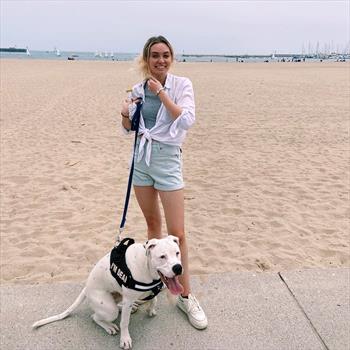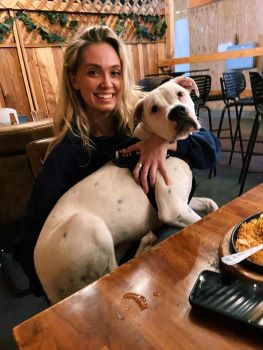Pigeon 2

Photo courtesy of Emma Scher
In late November of 2020, I had recently moved away from my college life to live with my parents. In the throes of the second wave of COVID, LSAT studies, and senior-year midterms, I was quarantined with few friends in town, went through a bad breakup, and there was no vaccine or pandemic end in sight. I was, to put it shortly, very depressed.
My grandmother, a veterinary technician who has administered small-animal newborn care since retiring at the Escondido Humane Society in 2005, thought that helping her foster two puppies might raise my spirits and entertain my parents. She had two Boxer mixes, a boy and a girl: he was completely white and she was brown.
I knew my dog was special the day that I met him. The two had been pulled from their mother after only a few days because she had been digging holes, attempting to bury them alive. Pigeon slept deeply, in the crook of my arm or neck, alone on the couch, or outside through the noise of the rushing cars from the nearby freeway. His blue eyes tracked ours as we walked across the room. I bottle fed him every night and we slept in the same room.
When the rescue came knocking about a month later asking for photos to put on the adoption website, I insisted on adopting him as an emotional support animal. His paperwork went through on Christmas Eve, and that same night my mom and I realized what was so special about him.
My dog was scratching at the door to go out, and then turned to play with the doorstopper on the wall next to it. I got up and opened the door, called for him to come, and he ignored me. “It's like he's deaf,” my mom joked.
I called him again, to which there was still no reaction, and we both paused to look at each other, realizing just how likely that might be. That night when he fell asleep, we applauded next to his face, screamed from behind him, and blew whistles in the room, and he slept soundly on, his snores sounding like the coos of a pigeon – that's how he got his name.
The next day, our veterinarian confirmed that Pigeon was deaf in either one or both ears. Whether dogs are unilaterally or bilaterally deaf, an ear typically loses the ability to hear entirely rather than partially if the dog is deaf since birth. It's not possible to get the hearing back, according to Dr. George Strain, a deaf dog and deaf cat expert at Louisiana State University's School of Veterinary Medicine.
The discovery was jarring—I had grown up listening to my grandmother give training tips to her adoptees, but a lot of the advice was vocal, and what I'd learned about hand training was in tandem with tonal training. Adopting a dog in college was already ambitious, and I worried that I wasn't able to provide proper care.
As I did more research, I learned that deafness can be more prevalent in certain phenotypes, such as white dogs, patched dogs, and dogs with a blue eye or eyes. The Merle phenotype is associated with a higher prevalence of both deafness and blindness. Breeds such as Dogo Argentinos, Dalmatians, and white-coated Boxers also have higher-than-normal rates of deafness.
I also learned about the trials that deaf dogs go through when finding a home. Some owners return their dogs unaware of their deafness, citing behavioral issues. Others rehome them immediately after the discovery. The Dalmatian Club of America still leaves it to the discretion of breeders whether they want to euthanize puppies that they've discovered to be deaf in both ears if they can't ensure that potential placement candidates will socialize, train, and provide for the puppy for their entire life. For many puppies, deafness is a deaf sentence.
Pigeon 1

Photo courtesy of Emma Scher
Ultimately, I decided to keep Pigeon and started the training process over. I asked my grandmother what I should do; she gave me all of the advice she had about body language and hand training. To fill in the gaps, I looked for deaf dog communities, finding a lot of tips in places like deafdogsrock.com and Facebook groups.
For the first few months, we worked strictly on establishing the association between yes and no. We gave him a thumbs up and a treat when he did behaviors we liked. For the behaviors I didn't like, I would touch my index finger, middle finger, and thumb together to signal a “no.” I began learning signs in proper American Sign Language, which I taught myself as I worked different commands into his routine.
Then, I started training him to check in frequently with a finger snapping motion—he couldn't hear the snap, but the flick in his field of vision caught his attention and told him to look at me for more signs. When he looked, he'd get a treat.
After he had all of his vaccinations, leash training was trickier, but it was an important component because deaf dogs should not be off leash unless they're in an enclosed area. Oncoming traffic is a double whammy: they can't hear cars coming, and they can't be recalled easily. I got him a collar and harness that clearly announced he was deaf so that others would know how to communicate with him.
As we learned more about each other, I made personalized adjustments to his training. Learning ASL tended to slow down picking up a new command, so I started inventing my signs on the fly. I learned that “no” worked better when paired with a mom stance: hunched over him with my hands on my hips. Pigeon and I developed our own language.
I learned that he took many cues from my parents' dog, including how to walk on a leash, and when to look out the window for a letter carrier. But mostly, I learned that training him isn't all that different from a hearing dog. Dogs are adaptable, and since he has been deaf since birth, there was nothing for him to miss.
Other than a few small quirks, like not going into off-leash areas, getting into his field of vision to give him commands, and sleeping with a night-light on, Pigeon's deafness was just a fact of life. He was just as intelligent, loving and independent as any other Boxer.
In Pigeon's case, there were even some surprising benefits to deafness: he doesn't bark at every noise, I don't have to spell out P-A-R-K, and I was able to move him into a city with no worries of anxiety from the increased noise. I can blast music and sing in my car without making any dogs uncomfortable (though human passengers are another story). He loved fourth of July fireworks.
It saddens me to think how many of these animals have been put down, returned, or rehomed solely on behalf of their deafness. With proper education, patience, and consistency—the same essential ingredients needed to train a hearing dog—owners could give these special dogs a chance at life.
It may have been a little harder, but it's mostly just different. If I can do it as a single, first-time pet owner, I'm confident others can too. Rescues would be remiss not to encourage families to do their research and study the signs of deafness to try and make homes accessible for them.
If you find out your puppy is deaf, understand that their deaf sentence doesn't have to be a death sentence. Your bond with a deaf dog may be greater than one with a dog who can hear.
4 Comments
Patty Moon
August 8, 2023
Janice Hussey
March 4, 2022
Taffi Tippit
November 7, 2021
Andrea Slaugh
October 30, 2021